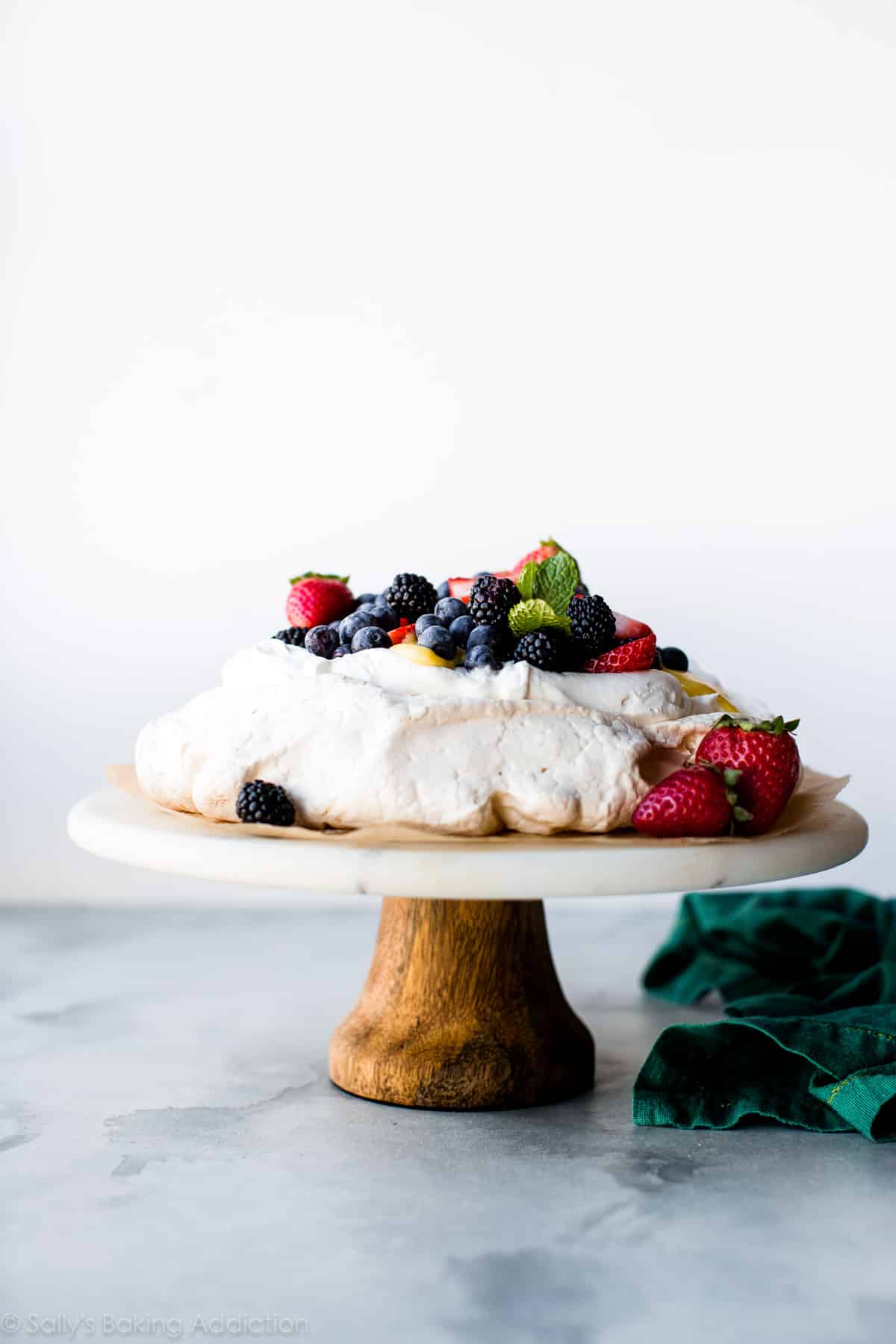
Another fresh and exciting recipe for you!
What is pavlova? Pavlova is a dessert popular in New Zealand and Australia. It’s not as common here in the states, but I hope to help change that! A texture lover’s dream come true, pavlova is made from egg whites that are slowly baked in a relatively cool oven. The egg whites take on a chewy-crisp texture on top, a soft marshmallow texture inside, and a crunchy crisp texture around the edges. That’s three completely different textures in one single bite. The crunchy edges are just like meringue cookies.
Pavlova loves to be dressed up with assorted toppings, mainly fresh whipped cream and piles of fresh fruit. Naturally gluten free, pavlova is light, sweet, and screams warm weather favorite. Happy spring, my friends, we’re making PAVLOVA!!
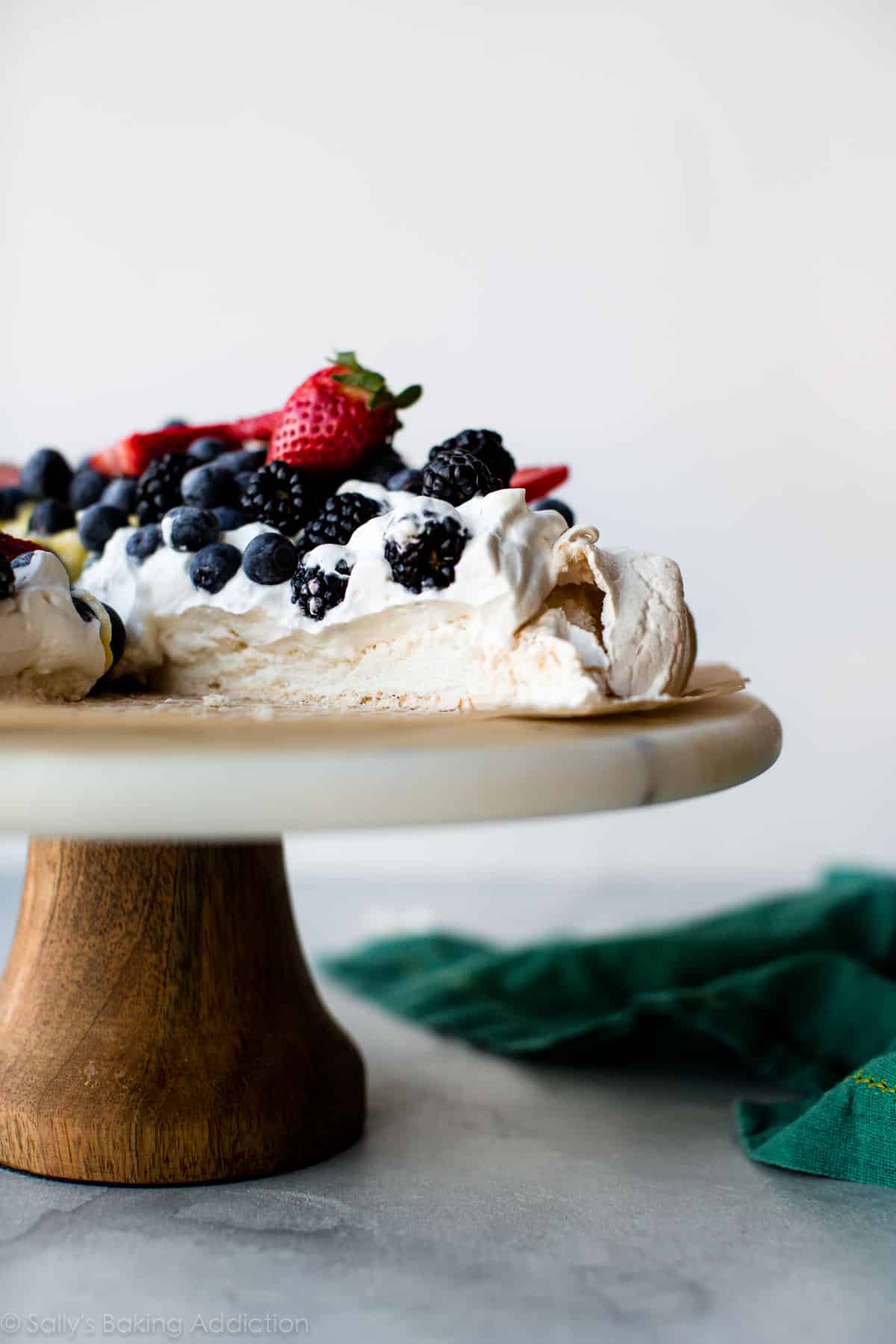
Video Tutorial: How to Make Pavlova
To obtain the unique pavlova texture, you must adhere to an exact recipe. While it’s fun to play around with ingredients, pavlova is not the time to stray from what’s listed. It’s picky, but picky doesn’t mean difficult. In fact, you only need 5 ingredients to make pavlova and I bet you have each in your kitchen right now:
- Egg whites
- Sugar
- An acid such as cream of tartar or vinegar
- Cornstarch
- Vanilla extract
Let me explain why these ingredients are used.
Pavlova Ingredients
- Egg whites – beaten into stiff peaks, egg whites are the base and volume of pavlova.
- Sugar – in addition to sweetening the dessert, sugar stabilizes the egg whites by holding them together both in the oven and as the whole pavlova cools. Without sugar, the protein molecules (science!) in egg whites will collapse. Additionally, sugar helps achieve the delightfully crisp texture. (Sugar is so much more than a sweetener in our baked goods.) Speaking of sugar, make sure that you use superfine or castor sugar. Just pulse sugar a few times in a food processor to reduce the size of the crystals.
- Acid – you can use 1/2 teaspoon of cream of tartar or 1 teaspoon white, apple cider vinegar, or even lemon juice. The pavlova will NOT taste like vinegar, I promise. The acid helps the egg whites hold onto air and, like the sugar, helps prevent the egg whites from collapsing. I tested with both and I actually prefer cream of tartar. I found that my pavlova spread a bit more when I used liquid acid.
- Cornstarch – I tested pav with and without cornstarch. I found that the center was fluffier and more marshmallow-y with cornstarch. Then I tested with 1 teaspoon cornstarch and 2 teaspoons cornstarch. I found it was a little chalky tasting with 2 teaspoons. I’m sticking to 1 teaspoon.
- Vanilla extract – purely for flavor!
(Not sponsored by any of these companies, but here’s exactly what I use.)
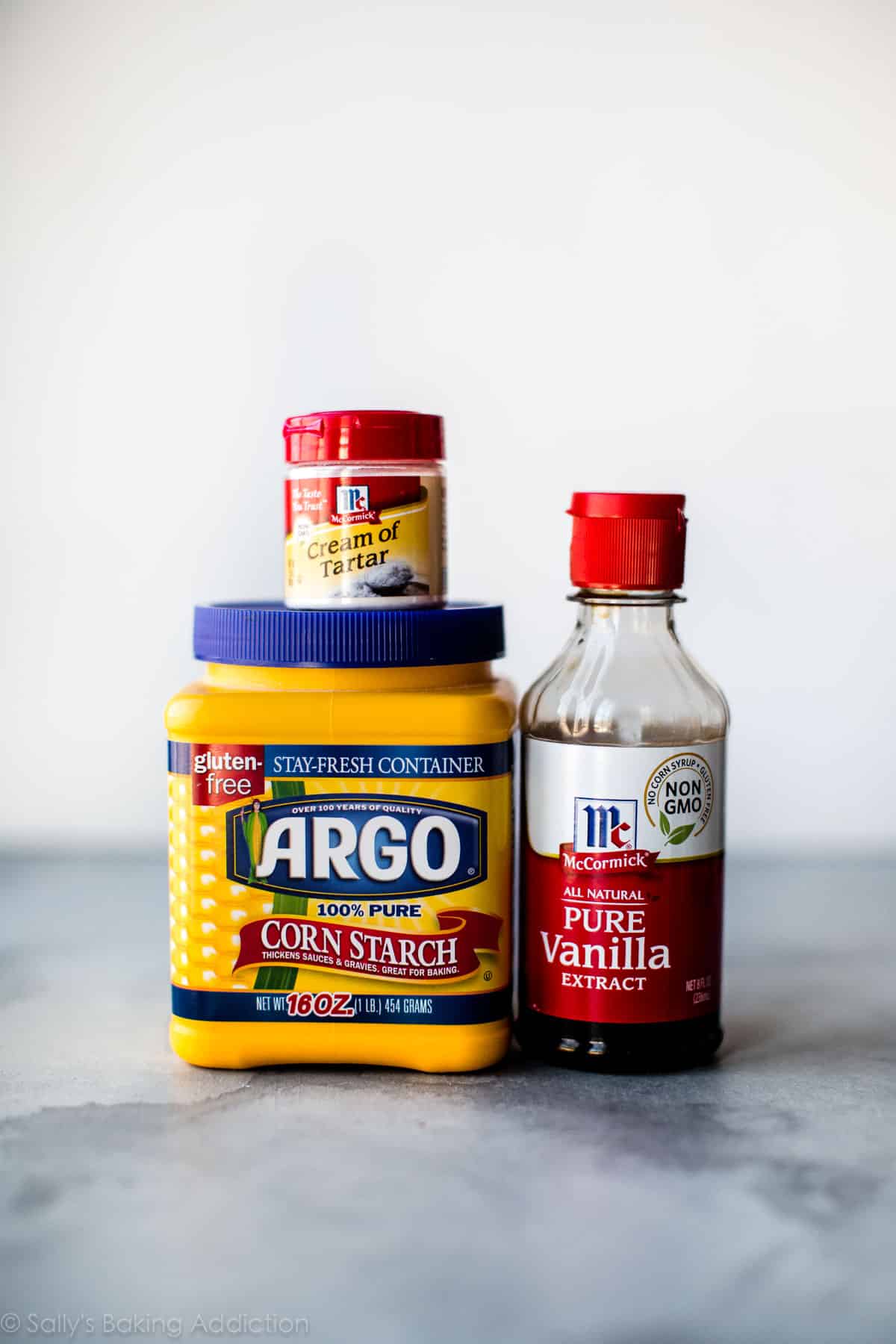
Ingredients are simple and method is effortless. There’s plenty of downtime when making pavlova. All you really have to do is watch it beat in your stand mixer then check on it in your oven. Kick your feet up!
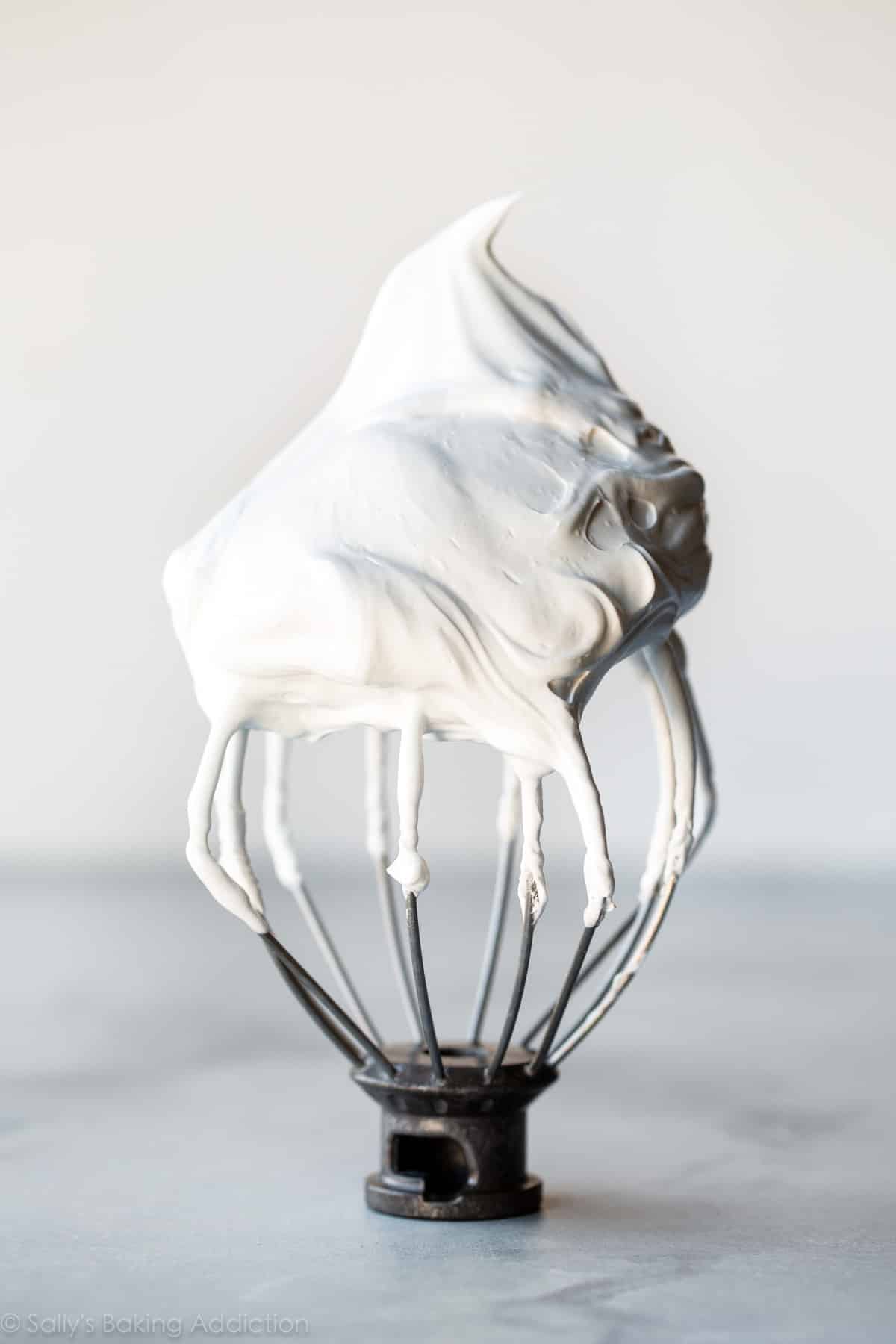
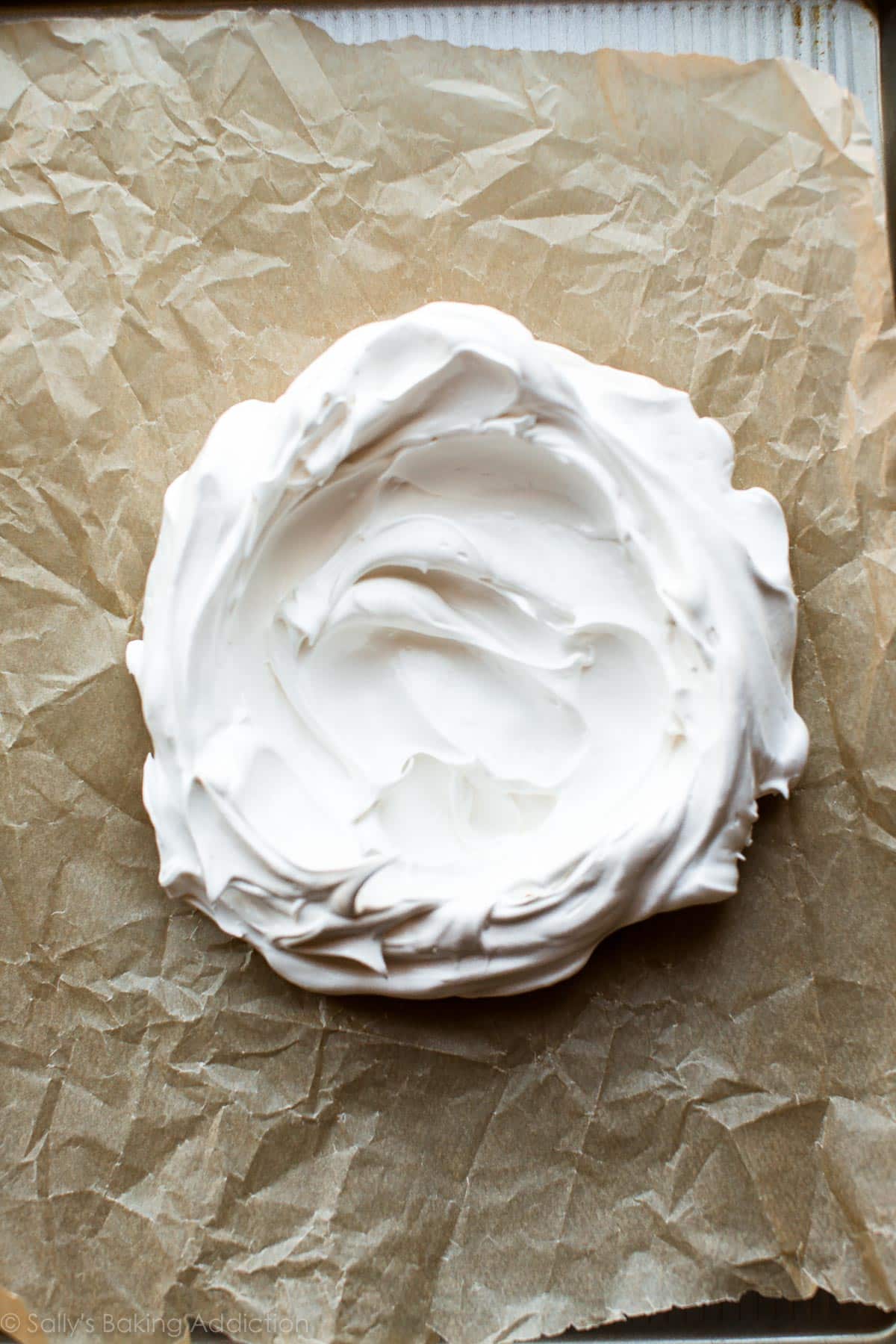
Just like our chocolate swirled meringue cookies and the meringue on our lemon meringue pie, whip the egg whites into super stiff peaks. Stiff enough that you can hold the whisk over your head and feel confident that the whipped egg whites won’t drop. 😉 Then you’ll spread the pavlova mixture onto your lined baking pan. You can use parchment paper or a silicone baking mat. Do not grease the baking pan—use a nonstick surface instead. Spread it into a circle, about 8-9 inches in diameter. You can eyeball it or trace one with a pencil. I just eyeball it. Like I did in the lemon meringue pie video, use the back of a spoon to create decorative peaks. Make sure the edges are tall and you have a nice dip in the center. That’s were we’ll pile our whipped cream and fruit!
Alternatively, you can make mini pavlovas. Here I piped the mixture into 6 mini pavlovas using Ateco 849. A piping tip isn’t necessary—you can just spoon it on. Again, make sure you leave a dip in the center to hold the toppings.
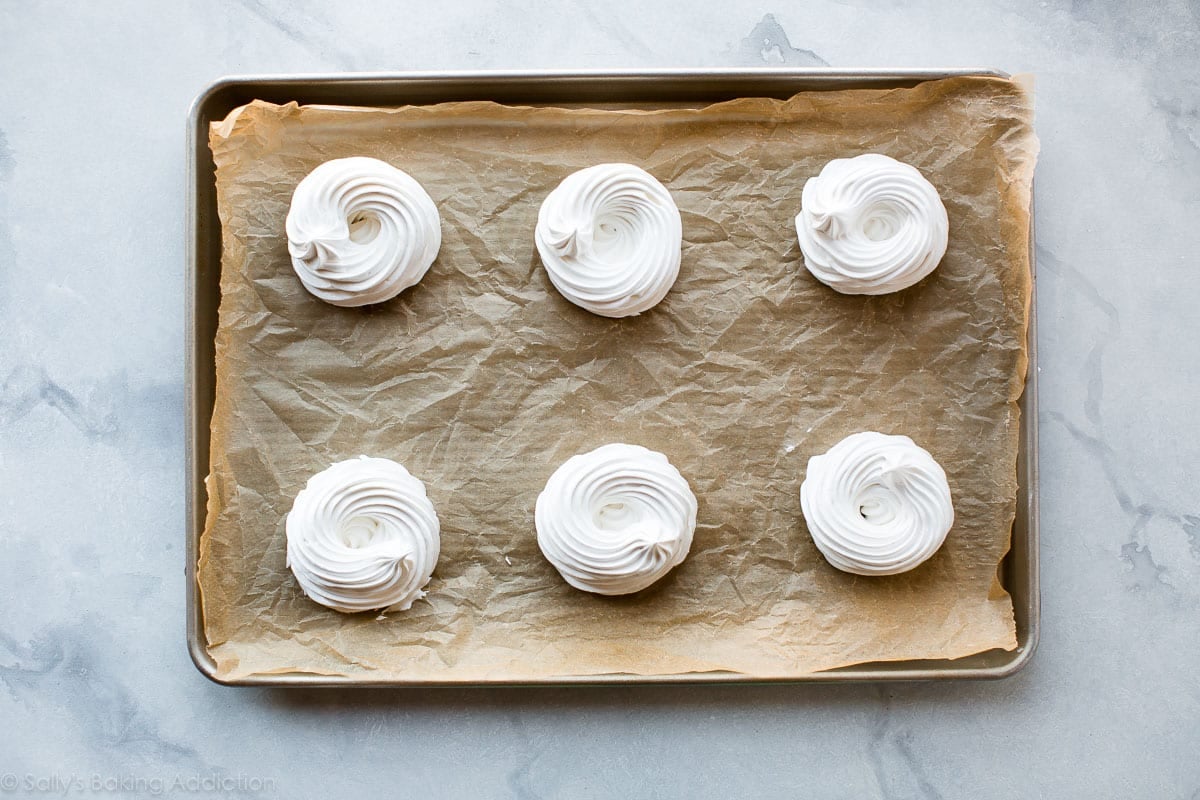
A relatively cooler oven is imperative for properly cooking your pavlova, but let’s start the pavlova at 350°F (177°C) then reduce it down to 200°F (93°C). I do this to help “set” the outer crust quickly. This trick helps reduce spread.
A properly cooked pav is pale in color. Cracks and bumps are par for the course, but the pavlova shouldn’t completely deflate. Especially if you follow the precise measurements and instructions in the recipe. You can help avoid too many cracks by cooling the pavlova in the oven. The sudden change of temperature (inside the oven to outside the oven) shocks the pavlova, so it’s best to cool inside the cooling oven.
Make sense?
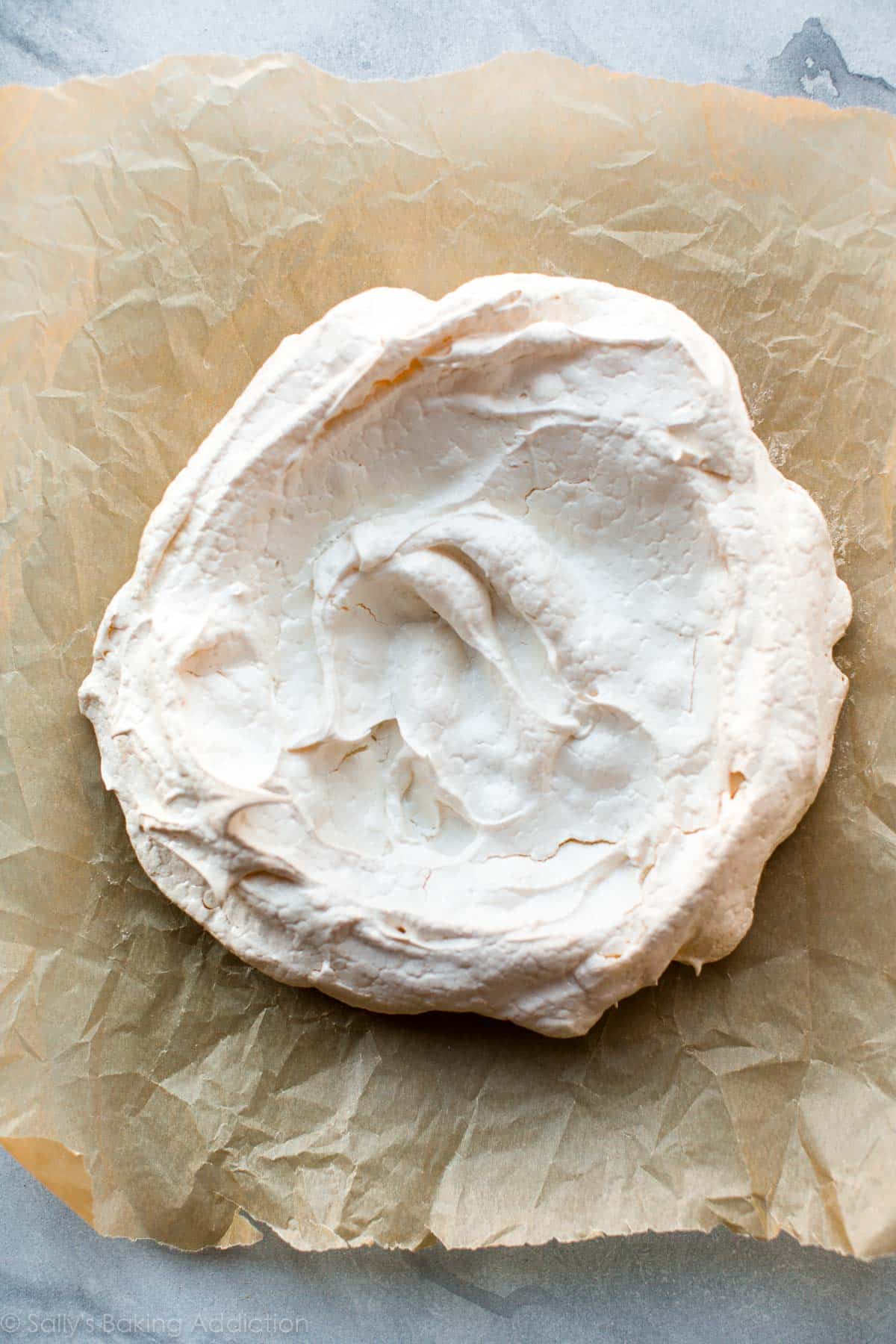
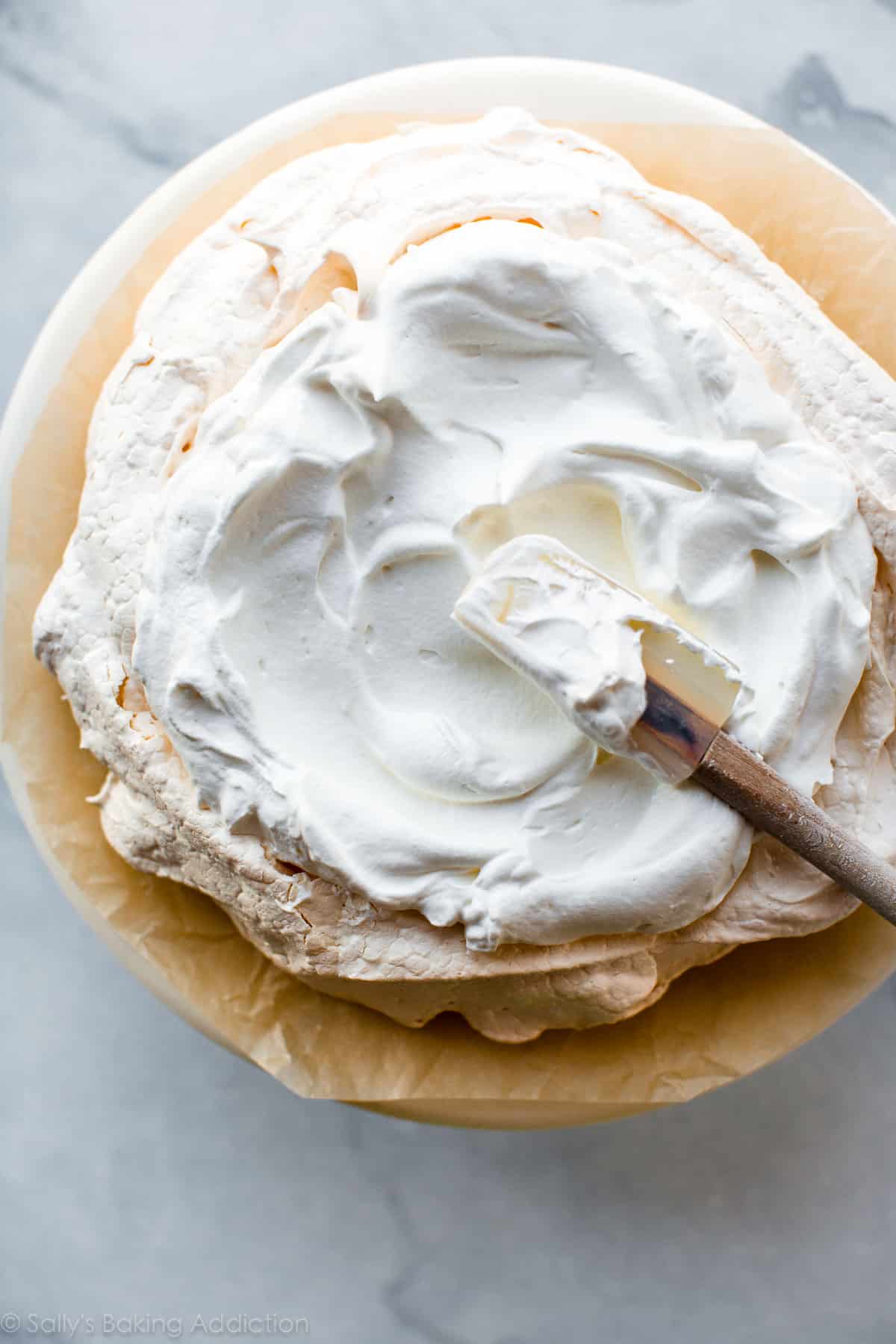
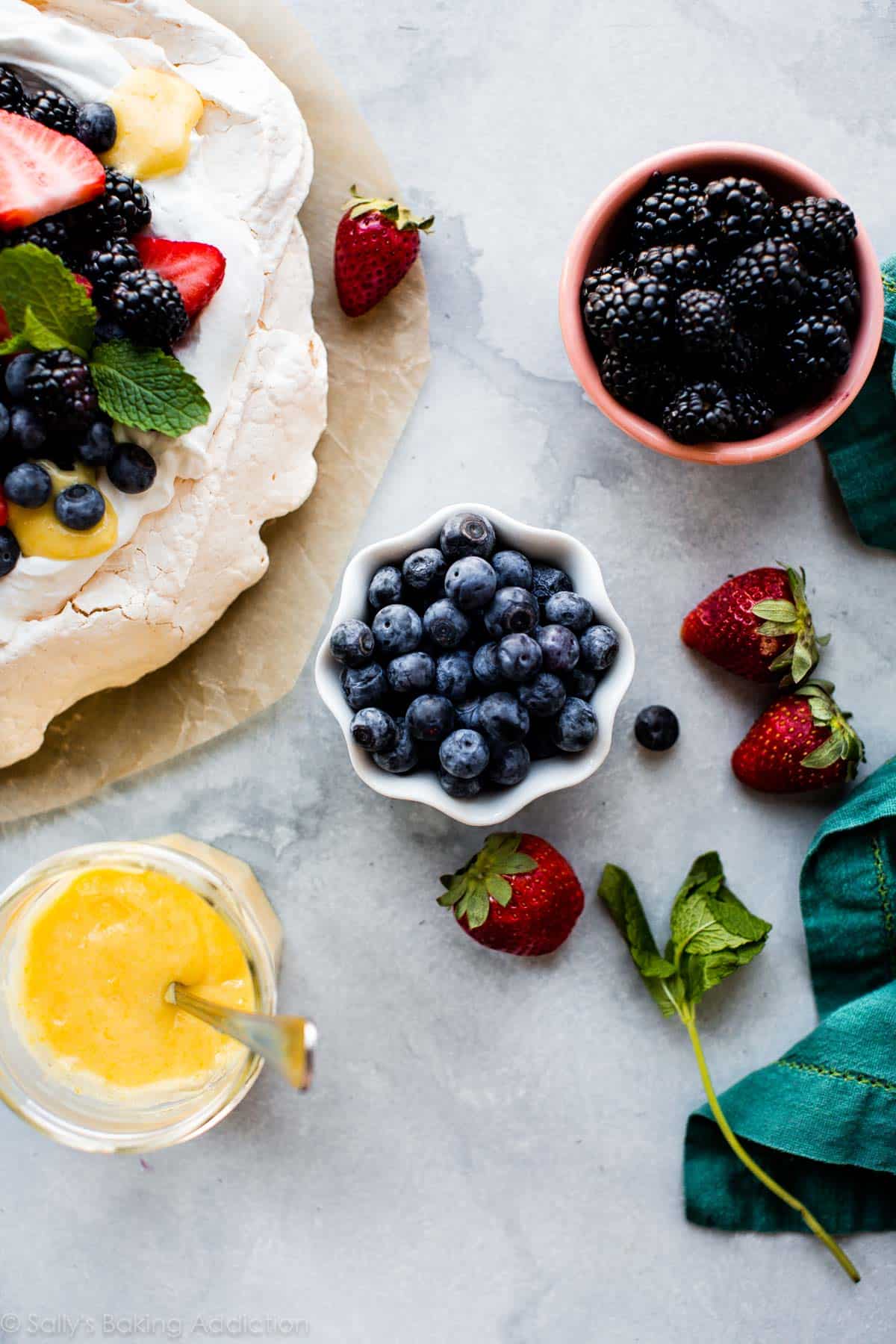
You can top your pavlova or mini pavlovas any which way, but here are some of my topping suggestions:
- Whipped cream is essential. You can get a little creative and flavor your whipped cream. Here are some fun flavored whipped creams.
- Homemade lemon curd. You’ll have exactly 4 egg yolks leftover anyway.
- A lot of fresh berries… enough to make a fruit pizza jealous!
- Edible florals and herbs
- Strawberry sauce, raspberry sauce, or blueberry sauce
- Chocolate shavings
- Seasonal fruits like mango, kiwi, passionfruit, blood oranges
No need to get artistic, just pile it all on top into a massive pavlova mountain.
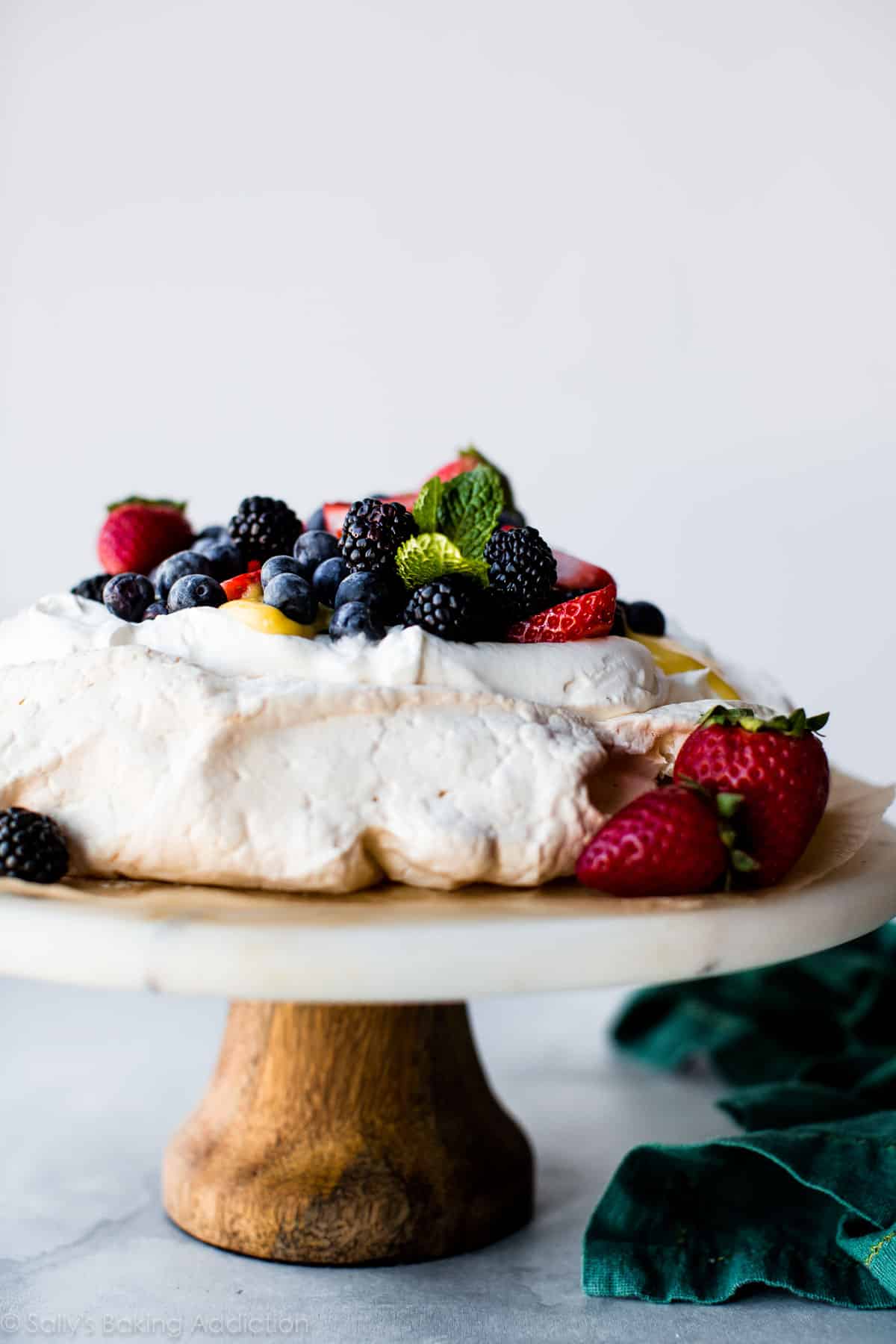
Things are bound to get a little messy when slicing, but if you cooked the pavlova long enough so that the bottom is crisp and the edges are set, it will hold a pie slice shape. This big thing serves about 8-10 people!
If you’re still on the fence about trying pavlova, might I remind you that the center tastes like marshmallows.
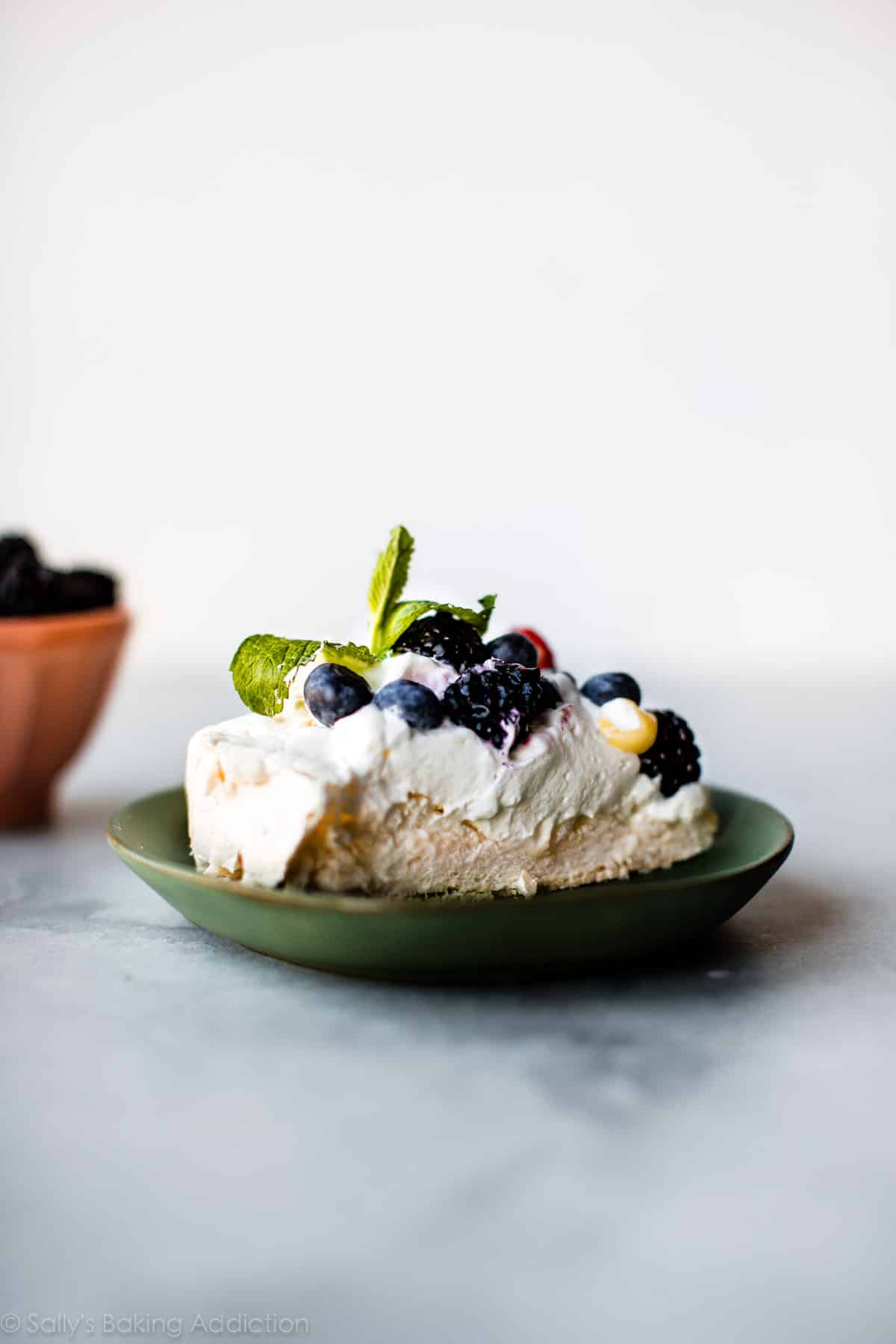
Have fun!
For more gluten-free baking inspiration, here are 40 gluten-free dessert recipes that are always a hit, including cranberry frangipane tart and flourless chocolate cake.
Print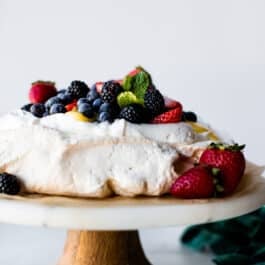
Pavlova
- Prep Time: 20 minutes
- Cook Time: 90 minutes
- Total Time: 4 hours
- Yield: serves 8-10
- Category: Dessert
- Method: Baking
- Cuisine: New Zealand
Description
Pavlova is crisp on the edges, chewy on top, and marshmallow soft and creamy in the centers. Pile high with lemon curd, whipped cream, and fresh fruit to make a naturally delicious gluten free dessert!
Ingredients
- 4 large egg whites (use the yolks for lemon curd!)*
- 1 cup (200g) superfine sugar*
- 1 teaspoon pure vanilla extract
- 1/2 teaspoon cream of tartar*
- 1 teaspoon cornstarch
Toppings
- Homemade whipped cream, fresh fruit, strawberry topping, lemon curd, or any desired topping (see post for suggestions)
Instructions
- Preheat the oven to 350°F (177°C). Line a large baking sheet with parchment paper or a silicone baking mat. (Preliminary note: you will quickly reduce the oven to 200°F (93°C) in step 4.)
- With a handheld mixer or a stand mixer fitted with a whisk attachment, beat the egg whites on medium-high speed until soft peaks form, about 5 minutes. Add the sugar in 2 additions, beating for 30 seconds between. Once all of the sugar has been added, turn the mixer up to high speed and continue beating until glossy stiff peaks form, about 2 minutes. The peaks should be stiff enough that you can hold the whisk upright and the peaks won’t move. Add the vanilla extract and beat for 1 more minute. The peaks should still be very stiff. If not, keep on mixing on high speed. Using a rubber spatula, fold in the cream of tartar and cornstarch.
- Spread the pavlova mixture into an 8-9-inch circle (see note for mini size). You can make decorative peaks with the back of a large spoon if desired. Make sure the edges are relatively tall and there is a nice dip in the center.
- Place pavlova in the oven. As soon as you close the oven door, reduce heat to 200°F (93°C). The pavlova will stay in the oven as it cools down to 200°F (93°C). Bake until the pavlova is firm and dry, about 90 minutes total. Rotate the baking sheet if you notice some spots browning. Try to limit how many times you open the oven as the cool air will interrupt the baking.
- Turn the oven off and let the pavlova cool inside the oven. Once the pavlova is cool, you can store it covered at room temperature for up to 2 days. Or serve right away.
- Once cool, top the pavlova with whipped cream and assorted toppings. Slice and serve.
Notes
- Make Ahead Instructions: See step 5 for making the pavlova in advance. Pavlova is best enjoyed right after it’s garnished. It doesn’t freeze well.
- Special Tools (affiliate links): Electric Mixer (Handheld or Stand) | Baking Sheet | Silicone Baking Mat or Parchment Paper | Marble Cake Stand or Serving Platter
- Egg Whites: (1) Room temperature egg whites whip faster than cold egg whites. And (2) room temperature egg whites whip into a greater volume than cold egg whites. So make sure your egg whites are at room temperature before beginning.
- Sugar: Superfine sugar dissolves easier into egg whites. To avoid tasting sugar granules, pulse 1 cup granulated sugar a few times in a food processor. You now have superfine sugar to use in the recipe.
- Acid: You can use 1/2 teaspoon of cream of tartar or 1 teaspoon of white vinegar, apple cider vinegar, or lemon juice.
- Mini Pavlovas: Divide pavlova mixture up into individual portions instead of spreading into one large 8-9-inch circle. In the photos, I piped the mixture into 6 mini pavlovas using Ateco 849. A piping tip isn’t necessary—you can just spoon it on. Make sure you leave a dip in the center to hold the toppings. Bake time depends on size, see step 4 for what to look for. If making 6 mini pavlovas like I did, bake for 35-40 minutes at 200°F (93°C). Start them in a 350°F (177°C) oven, like I do in this written recipe.
- Pavlova base from reader Laurel. Thanks, Laurel!



















Turned out great
It turns out perfect. I bake the pavlova in the shape of the age of my grandsons for their birthdays. Piled with whipped cream and fruit, it is a hit with all
Do you keep the Pavlova on the parchment paper to serve it or are you able to remove it?
Hi Deb, you can remove the pavlova from the parchment paper before serving if desired.
This is the easiest pavlova recipe I have found
LOVED the way you added the lemon curd to the mix. Using the “left-over” egg yolks and the addition of the creamy lemon is brilliant.
Just a word on the addition of cream of tarter. The acid in the cream of tarter interacts with the proteins in the egg whites, stabilizing and strengthening them to produce meringue with a higher volume and more stable structure. This happens when the cream of tarter is beaten into the whites at the start of the whipping NOT folded into the meringue at the end.
Would the cream of tartar be added before slowly adding sugar?
Haha. That’s absolutely why I am here.
Not going to lie. I’m wondering how many of us are here because our children would not stop asking for Pavlova after watching Bluey
Can’t wait to try this recipe.
Absolutely here because of Bluey lol. It turned out delicious! My kiddo that hates trying new things is devouring it.
How long does it take to cool it enough , in the oven,to fill it ?
Hi Janice! Probably about 1.5-2 hours.
Hi Kay! I am here for same reason! LOL! My granddaughter saw this on Bluey and absolutely had to have it! We are waiting for it to cool down now in the oven. Crossing fingers!
Yup, 100 percent because of Bluey but I’m also excited to try it! Currently cooking as we speak.
My siblings and I love to watch Bluey, so I wanted to surprise them with this! It’s nice to see others here for the same reason
Yep, here because of Bluey!
Yes Bluey peaked our interest
Totally here because of bluey!
I didn’t know what pavlova was and I’m the one that got curious after watching Bluey. Lol I’ve made it 4 times now. My kids are not as excited about it but, my husband and I love it. (The pavlova. We all LOVE Bluey)
Totally here because of Bluey!! Grandkids LOVED it!!
Came out PERFECTLY! Thank you! This is will be my go-to recipe for now on.
I love this recipe. I made it with Splenda instead of real sugar and it worked perfectly.
Hi Linda… How much Splenda did you use? Thanx in advance. 🙂
Grand daughter has been wanting Pavlova for months. Today was the day. Had a ball making it. Everything went well until we went to cut it and it deflated! Haha. Is that normal? That was great, a tad gritty. We did put sugar through food processor as recommended. Lemon curd did kit thicken as it should. We are it anyway and it was good. All in all, great recipe and will def give it another try!
Hi Mimi, the pavlova is doing to deflate a bit and crack as you slice it. Totally normal for it to get a bit messy!
That was amazing, and worth the effort. I would like to put it out there that this was not difficult, but rather very time consuming and the mixing/stirring portions demand my undivided attention. I had never had Pavlova, and have never made a meringue, or curd, but my kid said he wanted Pavlova, so by golly I set out to deliver. I invited the in-laws and said “at the very least, we’ll have fruit, berries and whipped cream”. Having not done anything like this before, I had no idea what to do or watch out for. I followed the recipe/timeline as closely as I could, put it in the oven and didn’t mess with it at all. My oven stays pretty true to temperature so I just had faith that it would all work out. My kid was over the moon (goal achieved), the in-laws were impressed and my wife was happy.
I agree with others about adding sugar slowly. Adding in 2 batches deflated the eggs and made it much harder to whip, took over 25 minutes on the highest setting on my hand mixer and they still never formed stiff peaks. Eventually I decided to bake it anyway (with soft peaks, gooey, marshmallow like batter) and it still ended up a pavlova, just a little flat! It got nice and crispy on the edges and gooey in the middle. Very good with the lemon curd also.
This looks amazing – I’m going to try it today! I’d love to switch out the sugar for Stevia, how will that affect it?
Hi Anna, We’d love to help but we are not trained in baking with sugar substitutes. For best taste and texture (and so you don’t waste your time trying to adapt this recipe since it may not work properly), it may be more useful to find a pavlova recipe that is specifically formulated for sugar substitutes. Thank you!
I used Splenda it worked fine.
Hi, I currently have my pavlova in the oven and it just doesn’t seem to be firming up. I followed the recipe and it’s been in there for almost 2 hours and still squishy when I touch it. Any idea why? Thanks!
Hi SS, does your oven run particularly cool? All ovens are different, so I would continue baking until it’s firm and dry. How long did it end up taking?
Hi Sally , do you think it would be fine to have it assembled with the whipped cream and kept in the fridge for serving 5-6 hours later ?
Thank you x
Hi Aneta, pavlova is best enjoyed right away once garnished. If making the whipped cream ahead, you can store those separately in the refrigerator and top the pavlova once ready to serve.
I have no idea where I went wrong but I could not get stiff peaks for the life of me I’ve used my hand mixer for about 35 minutes now and it’s still not where it needs to be. I added the sugar as directed – I saw another comment about adding the sugar little by little, could this be the issue? Thanks in advance!
Hi Darla, Try turning up the speed on the mixer– you may just need a faster whip. Additionally, try wiping down your mixing bowl and the whisk attachment with a *little* lemon juice before starting. This will help rid any grease residue that could be preventing the mixture from reaching stiff peaks.
As a kiwi, I have tried several recipes for Pavlova – this is the best! (my family happily told me so!) I used a hand-mixer, followed all Sallys detailed instructions, and I was thrilled with the result. After many years using white vinegar, I was interested to use cream of tartar instead, now I’ll never use any other Pav. recipe. The thing that put my Pav. over the top was using Sallys recipe for lemon curd along with whipped cream, kiwi and strawberry on top.
I have a houseful of picky eaters, and your pavlova delighted every one! Huuuuuuge success, and so festive for Christmas Eve! And easier than I could have imagined. Thanks for this, and all your wonderful recipes! Sally is my go-to
First time I made it, it failed because adding the sugar as it says, it’s too fast. Second time, it was perfect by adding the sugar very slowly 1 tablespoon at a time. BUT I missed the “lower the oven to 200” instructions. Very frustrated because it was perfect before going in the oven! So keep in mind: you have to put in the sugar a lot slower AND remember to lower oven temperature.
I happened to enjoy this made by my Australian friend long time ago. Haven’t made it for a while because there’s usually a large crowd and with only one oven it’s a problem. Now I see that it will hold at room temperature for 2 days so I will be making it for this Christmas and I am very excited.
Glad to read about not using powdered sugar finding extra fine sugar can be difficult so I will use my processor as stated.
Appreciate the information.
Loved the recipe….how do you cut this?
Hi Lorna, Things are bound to get a little messy when slicing, but we slice it like a pie. Enjoy!
What is the longest period of time the pavlova shell can keep before adding the cream and fruit?
If i wrap it in tin foil would it help to keep longer?
It’s best to bake pavlova as close to eating it as possible, because it can begin to be affected by humidity and moisture in the air. But once the pavlova is cool, you can store it covered at room temperature for up to 2 days.
I actually got 16 individual (3”) merengues from this recipe. I also substituted Grand Marnier for the vanilla and they are delicious! Going to pair with lemon curd and berries with chantilly cream for a girls’ brunch.
Don’t be afraid to whip your egg whites until they are really stiff. Also, if they are soft, pop them back in at 200 degrees for 5-7 minutes at a time until firm enough.
This looks great but quick question. How far in advance can I assemble this before serving, and I assume it should be kept in the fridge? Planning on lemon curd, whipped cream and macerated fruit. Thank.you!
Hi Ellen, pavlova is best enjoyed right away, but once it is cool, you can store it covered tightly at room temperature for up to 2 days. If making the lemon curd and whipped cream ahead, you can store those separately in the refrigerator and top the pavlova once ready to serve.
Why did mine fall! I followed the directions exactly but after the few hours of no heat it was flat when I removed it- so sad!
Hi Nancee, pavlovas will fall. You can see mine deflated in the photos, as this leaves room for all of your toppings! Did yours fall more than what you see? (I know it’s hard to tell, but was it completely flat?)
Hi Sally! I’m so excited to try this out for a Christmas party next weekend. I plan on using whipped cream and lemon curd to top it. Would you use the whipped cream as a base, then dollop the curd on top? Or have the lemon curd first, then top with whipped cream?
Thank you so much!
Hi Michelle! We would do whipped cream first, then lemon curd on top. Hope it’s a hit!
I do it the other way lemon curd as the base then whipped cream and berries on top.
I really appreciate that you always provide measurements by weight! Thank you for this and many other recipes.
Hi Sally, love using your recipes!
I made the individual, and just read good for only 2 days! I will be filling them in 3 day with your lemon curd & fruit. If I refrigerate them will the hold up and last?
Hi Lori, pushing this to 3 days would be just fine. Keep at room temperature.
Hi Sally, I tried this last night in my oven and it was still a bit soft and sticky on the outside when I took it out of the oven . I just used the normal bake setting. Should I be using the convection setting? I also used powdered sugar instead of standard granulated, any ideas what my problem might be?
Hi Melissa, All of the recipes on this site are written for conventional settings. Convection ovens are fantastic for cooking and roasting. If you have the choice, we recommend conventional settings when baking cakes, breads, etc. The flow of air from convection heat can cause baked goods to rise and bake unevenly and it also pulls moisture out of the oven. If you do use convection settings for baking, lower your temperature by 25 degrees F and keep in mind that things may still take less time to bake. Powdered sugar is too fine and fluffy for the recipe. Hope that helps for next time!
Cindy- I saw that same show, and I also did a search to wind up here! I can’t wait to try making this on Tuesday!
After watching contestants make Palova on Holiday Baking Championship on Food Network, I said I’m going to try and make it . So I did a search on my phone for a Palova recipe and found yours. It was so easy and fun to make. When I took them out of the cooled down oven and tried a piece, I was blown away. OMG!!! It was absolutely perfect. Crunchy on the outside and chewy soft on the inside. I can’t fricken get over how delicious it was. This is my new favorite thing to make, and will be gracing my friends and family with these gems this Christmas.
I am now a subscriber and can hardly wait to receive new recipes and baking tips from you.
Cheers!!
Welcome, Cindy! We are so happy you enjoyed this recipe so much!
I’m excited to try this recipe. I do not have a whisk attachment for my hand mixer. It it a must?
Hi Carolyn, beaters on a hand mixer should work just fine. It may take longer to whip up.
Cindy that’s the same reason I came searching for a Pavlova recipe, I can’t wait to try this for Christmas.